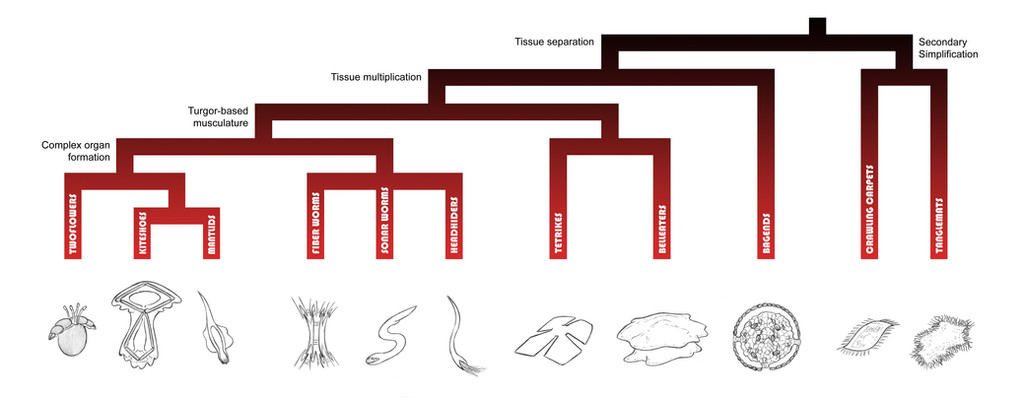HOME | DD
 Zerraspace — Zainterian Tree of Life - Koilozoa
Zerraspace — Zainterian Tree of Life - Koilozoa

Published: 2016-08-06 07:46:24 +0000 UTC; Views: 2822; Favourites: 16; Downloads: 10
Redirect to original
Description
When I started the Zainter project, I claimed there were 11 animal phyla, though I routinely joked that there were in fact forty or so in total, the remainder being minor worm-like things. Said comment can be considered largely true of animal life on Earth as well, though depending on how finely you slice it, there may be 30 to 60 such phyla. As such, I think I can consider the following an accomplishment.
You see, while mulling over this at some time, I decided to more closely examine how the various phyla were related, looking to Earthly phylogenetic trees for inspiration, at which point I became determined to create a similar effort of my own. There are now 27 phyla, split amongst two domains distinguished by their differing cellular characteristics. On Deviantart, I will be dealing with each of these separately.
The Koilozoa have no presence on land, save for the twoflowers, but are much more important underwater where they are much more diverse. The original Koilozoa was a single cell sheet reminiscent of a slime mold, with all cells capable of functioning on their own, hence the retaining of mitochondria-like organelles. They have fewer phyla, but those groups that are successful tend to have far more species, and their composite phyla can be listed as such:
- Twoflowers: shelled organisms in which the original outer bell has ossified, and the inner bell has turned into shell-sealing limbs. The greater body are filterfeeders with little in the way of internal organs, but a few have dedicated systems and display incredible activity.
- Kiteshoes: organisms possessing a scissor-like skeleton that is used to pump fluid in and out of their bodies, both to handle food and propel themselves with water.
- Mantlids: organisms possessing an on-demand skeleton based on turgor-reliant musculature, mantlids are capable of changing their form to better suit their surroundings and more easily propel themselves based on current water conditions.
- Fiber Worms: also known as team worms, these organisms bind themselves together to form a colony in which each body takes on its own functions, mimicking the workings of a single larger organism.
- Sonar Worms: organisms possessing a specialized resonance chamber that allows them to direct intense bursts of sound. They are mostly specialized exo-regicon parasites, using their high-frequency emissions to break through their prey’s hard shells.
- Headhiders: largely parasitic organisms that burrow into surfaces using their thin bodies, leeching nutrition through whatever fluid seeps in, and exposing only their reproductive organ to spread their young to find new homes.
- Tetrikes: organisms with segmented panel-like bodies, they are close relatives of the belleaters but are capable of active motion and predation, even if their activity is generally to shift their panels to better catch oceanic currents.
- Belleaters: organisms consisting of multiple connected layers of skin, generally forming cavities that are semi-specialized for digestion or locomotion. They are one of the most prolific groups on Zainter in terms of number of species and forms, though they are generally drifting filterfeeders and ambush predators.
- Bagends: large floating organisms, with a hard but porous external skeleton sandwiching filter feeding innards. The spaces within often provide homes for other organisms, autotroph and heteroph alike, and bagends tend towards mutual cooperation with their hosted species, which may even provide it nourishment.
- Crawling Carpets: organisms that are little more than actively moving sheets of cells, wandering filterdeers and predators the lot, the crawling carpets are probably the closest living organisms to the original Koilozoa.
- Tanglemats: secondarily simplified crawling carpets which have lost all musculature and can now only drift. They are universally filterfeeders but will, if allowed, eat anything – they simply attempt to digest whatever they come into contact with that isn’t part of their own body.
For more information, please refer to the Zainter Project gallery, or go to the Speculative Evolution website, Remake of Zainter page here: s1.zetaboards.com/Conceptual_E…
























